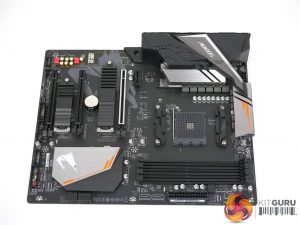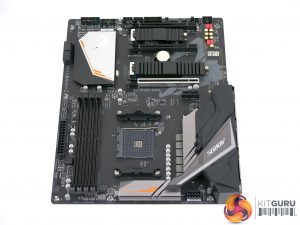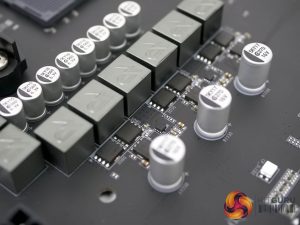The design and styling of the Gigabyte B450 Aorus Pro is smart, using predominantly black and grey colours with hints of silver and orange to give it the “Aorus flair”.
The integrated RGB lighting is bright and easy to control using the provided software. Lighting is provided in three zones – the B450 chipset heatsink, audio PCB and rear I/O shroud.
Gigabyte splits the SATA ports off into two chunks – the four ports that come via the chipset (black) and the two from the CPU (grey). There are some complex bandwidth arrangements between the M2 slots and the SATA ports to take note of – The 2 CPU provided SATA ports are unavailable when using a PCIe SSD in M2A or one CPU SATA port is unavailable when using SATA SSD in M2A. Chipset SATA ports 2 and 3 are unavailable when using PCIe SSD in M2B.
The two M.2 slots both feature an M.2 heatsink which is a nice touch at this price point. Both slots support PCIe SSDs but M2A will support PCIe 3.0 X4 or SATA III up to 110mm, whereas M2B supports only PCIe 3.0 X2 up to 80mm.
The audio package uses the latest high-end Realtek ALC1220 codec along with WIMA FKP2 and Chemicon audio capacitors, there is a headphone amplifier built into the codec package.
The rear I/O features an integrated cover and has the following outputs:
- 1 x HDMI 2.0 port
- 1 x DVI-D port
- 4 x USB 3.0 ports
- 1 x USB 3.1 Type-C port
- 1 x USB 3.1 Type-A port (red)
- 1 x RJ-45 port
- 1 x optical S/PDIF Out connector
- 5 x audio jacks
The CPU VRM uses an interesting 4+3 phase design that's definitely not 8+3 phases, but is still sufficient for the price point. The provided heatsinks are of adequate size but will inevitably have restricted airflow as a result of the cosmetic rear I/O shroud used to enhance the appearance of this motherboard.
Gigabyte is using an Intersil ISL95712 4+3 phase controller with the B450 Aorus Pro. In this particular configuration there are 2 inductors per phase for the VCore VRM and a single inductor per phase for the SOC VRM. Each VCore VRM phase has two low-side and one high-side MOSFET while the SOC phases have single high and low-side MOSFETs.
The low-side MOSFETs are ON Semiconductor 4C06N (69A) while the high-side MOSFETs are ON Semiconductor 4C10N (46A). There are 7 high-side and 11 low-side MOSFETs in total.
The four small ICs (ISL6625A drivers) between the MOSFETs are external drivers, of which there are two for the SOC VRM and two for the VCore VRM – the ISL95712 controller already integrates 2 drivers for the VCore and 1 driver for the SOC.
The capacitors appear to be 5K (5,000 hours durability) rated units, which are some way below the 12K capacitors often found on overclocking capable motherboards.
On the whole the VRM solution is entry level in terms of the capacitor and MOSFET selection, as well as the overall VRM structure. From previous KitGuru VRM analyses we found the MSI B450 Tomahawk to offer a better quality solution, while ASRock delivers the ISL95712 controller implementation better on the X470 Fatal1ty Gaming-ITX/ac in terms of MOSFET and capacitor selection.
That said the MSI B450 Tomahawk made sacrifices in other areas and the ASRock motherboard is considerably more expensive. On the whole the solution should be sufficient for the price point and the typical user in this segment.
 KitGuru KitGuru.net – Tech News | Hardware News | Hardware Reviews | IOS | Mobile | Gaming | Graphics Cards
KitGuru KitGuru.net – Tech News | Hardware News | Hardware Reviews | IOS | Mobile | Gaming | Graphics Cards


















